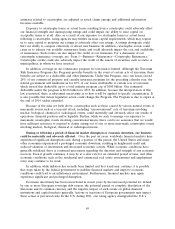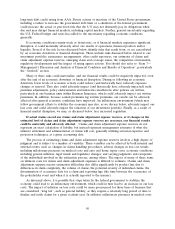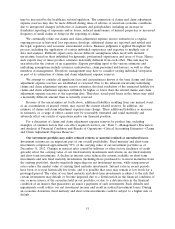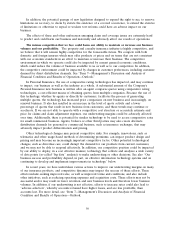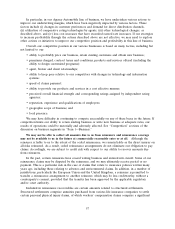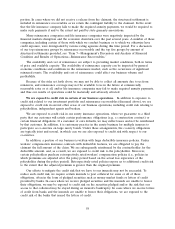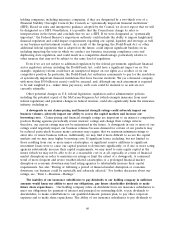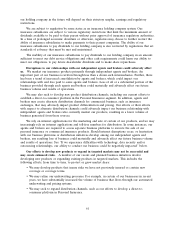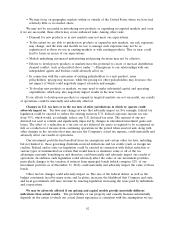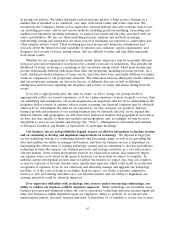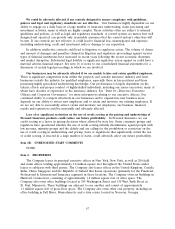Travelers 2012 Annual Report Download - page 70
Download and view the complete annual report
Please find page 70 of the 2012 Travelers annual report below. You can navigate through the pages in the report by either clicking on the pages listed below, or by using the keyword search tool below to find specific information within the annual report.portion. In cases where we did not receive a release from the claimant, the structured settlement is
included in reinsurance recoverables as we retain the contingent liability to the claimant. In the event
that the life insurance company fails to make the required annuity payments, we would be required to
make such payments if and to the extent not paid by state guaranty associations.
Many reinsurance companies and life insurance companies were negatively impacted by the
financial markets disruption and the economic downturn over the past several years. A number of these
companies, including certain of those with which we conduct business or to which we otherwise have
credit exposure, were downgraded by various rating agencies during this time period. For a discussion
of our top reinsurance groups by reinsurance recoverable and the top five groups by amount of
structured settlements provided, see ‘‘Item 7—Management’s Discussion and Analysis of Financial
Condition and Results of Operations—Reinsurance Recoverables.’’
The availability and cost of reinsurance are subject to prevailing market conditions, both in terms
of price and available capacity. The availability of reinsurance capacity can be impacted by general
economic conditions and conditions in the reinsurance market, such as the occurrence of significant
reinsured events. The availability and cost of reinsurance could affect our business volume and
profitability.
Because of the risks set forth above, we may not be able to collect all amounts due to us from
reinsurers, and reinsurance coverage may not be available to us in the future at commercially
reasonable rates or at all, and/or life insurance companies may fail to make required annuity payments,
and thus our results of operations could be materially and adversely affected.
We are exposed to credit risk in certain of our business operations. In addition to exposure to
credit risk related to our investment portfolio and reinsurance recoverables (discussed above), we are
exposed to credit risk in several other areas of our business operations, including credit risk relating to
policyholders, independent agents and brokers.
We are exposed to credit risk in our surety insurance operations, where we guarantee to a third
party that our customer will satisfy certain performance obligations (e.g., a construction contract) or
certain financial obligations. If a customer of ours defaults, we may suffer losses and not be reimbursed
by that customer. In addition, it is customary practice in the surety business for multiple insurers to
participate as co-sureties on large surety bonds. Under these arrangements, the co-surety obligations
are typically joint and several, in which case we are also exposed to credit risk with respect to our
co-sureties.
In addition, a portion of our business is written with large deductible insurance policies. Under
workers’ compensation insurance contracts with deductible features, we are obligated to pay the
claimant the full amount of the claim. We are subsequently reimbursed by the contractholder for the
deductible amount, and, as a result, we are exposed to credit risk to the policyholder. Moreover,
certain policyholders purchase retrospectively rated workers’ compensation policies (i.e., policies in
which premiums are adjusted after the policy period based on the actual loss experience of the
policyholder during the policy period). Retrospectively rated policies expose us to additional credit risk
to the extent that the adjusted premium is greater than the original premium.
Our efforts to mitigate the credit risk that we have to our insureds may not be successful. To
reduce such credit risk, we require certain insureds to post collateral for some or all of these
obligations, often in the form of pledged securities such as money market funds or letters of credit
provided by banks. In cases where we receive pledged securities and the insureds are unable to honor
their obligations, we may be exposed to credit risk on the securities pledged and/or the risk that our
access to that collateral may be stayed during an insured’s bankruptcy. In cases where we receive letters
of credit from banks and the insureds are unable to honor their obligations, we are exposed to the
credit risk of the banks that issued the letters of credit.
58



